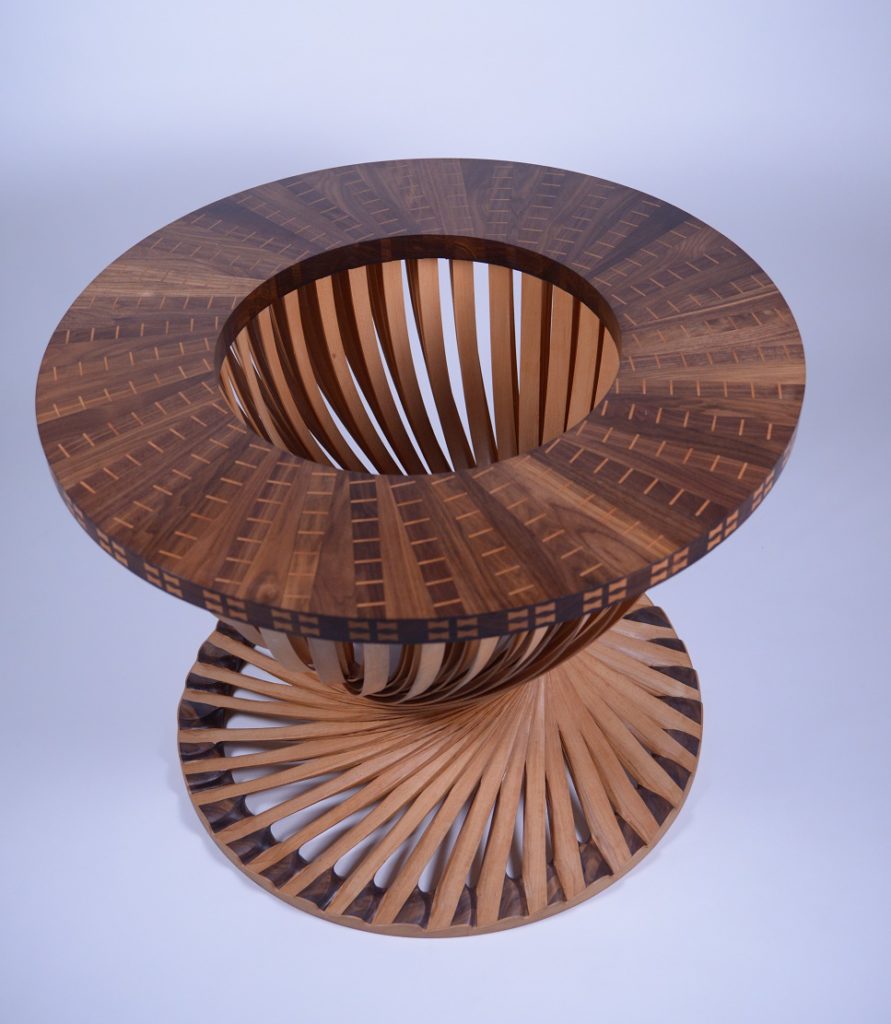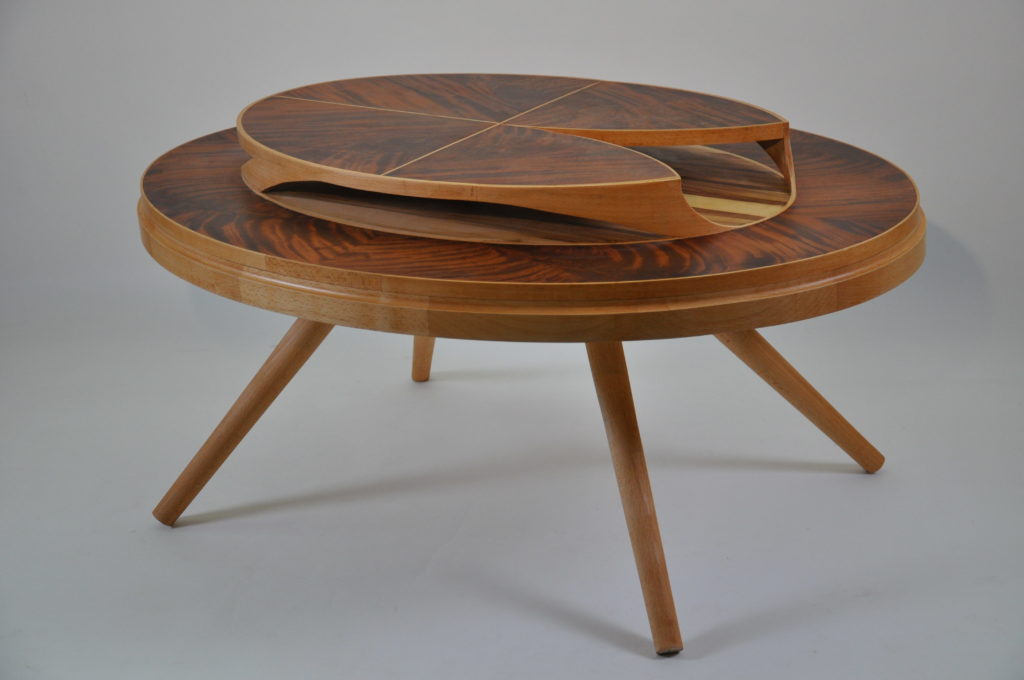By Donald H. Harrison

SOLANA BEACH, California – Exploring the Cedros Avenue Design District, Grandson Shor and I happened upon Justin Yasgoor, who was sanding a table top in the basement of the extensive David Alan Collection, which includes furniture and sculptures from various places around the world, particularly Japan and Indonesia.
Schmoozing with him, we learned that, notwithstanding the difference in spelling, he is of the same Yasgur family that back in 1969 permitted their dairy farm in Bethel, New York, to be used for the celebrated four-day Woodstock Music Festival, attended by up to a half million people.
We also learned that he was an accomplished woodworker, and that a handcrafted table, which he had named “Bridging the Gap,” was awarded the People’s Choice Award at the 2017 San Diego County Fair.

Yasgoor had work to do, so we couldn’t talk with him for very long on that day, but I arranged to interview him by phone a few days later. I knew I wanted to talk to him about Woodstock, woodworking, and, oh yes, after checking him out on YouTube, about playing the didgeridoo.
Karen and Stuart Yasgoor adopted Justin at birth in 1987 – 18 years after the Woodstock Music Festival. Growing up as a member of the historic outdoor concert’s host family “was a fun family fact,” he said. “More important for me is the tremendous amount of love and support that my family had provided me, including a home and the fact that I grew up in the Jewish tradition and faith, had a bar mitzvah, and resonated with a lot of the ethics and values that we have in our family.”
Somehow during the process of immigration from Europe, the spelling of the Yasgoor family name was changed to “Yasgur” but in subsequent generations the spelling was changed back, according to Justin.
Max Yasgur was a close friend and first cousin of Yasgoor’s grandfather, according to Justin. Max gave a short speech at the Woodstock Music Festival noting that the crowd may have been the biggest in history to attend a music festival, and yet, there was no violence, only music and fun throughout the entire four days. Allowing the festival to be held on his property, “Max took a big risk,” Justin related. The festival had been blocked at another venue, and “it was kind of last minute when he invited everyone over to his farm. He didn’t have enough accommodations for the amount of people who showed up, and in the immediate aftermath that was pretty messy,” Justin said. But it was one of the most important musical events in history.
Yasgoor said that Max’s example inspired him to become a “risk taker,” an apropos observation because the craftsman is now in the process of setting up his own business, in which he will be selling via his website, JDYasgoor.com, unique pieces of furniture, and possibly also will sell hand-crafted didgeridoos. He commented that the wind instrument created by Australia’s aboriginal people, is evolving into a mainstream musical instrument.
Woodworking was Yasgoor’s love from an early age. “I think it started with Legos and Lincoln Logs,” he said. “I always have been hands on, making things since I was a youngster. When I was four, I had an imaginary wood shop in my closet in my room.’ The best of his wood creations found their way into a portfolio that helped him win a scholarship to the California College of the Arts in the San Francisco Bay Area, where he perfected his craft.

I asked if he got his inspiration from woodworkers like George Nakashima, whose works are on permanent display at the Mingei International Museum in San Diego’s Balboa Park, or the fitted wood ceilings of the Crown Room at the Hotel del Coronado, or from any other works in San Diego County. He replied that while the works of other wood craftsmen are impressive, it’s not from finished works but from nature that he typically finds his inspiration. For example, he said, “I love the desert,” and enjoys field trips to the Anza-Borrego Desert.
More often, he said, ideas for furniture will come to him in either of two ways. Dreams are the first way. The “Bridging the Gap” table which has 1,500 separate pieces of wood, he dreamed about while in college, and then made a prototype. After college, however, he set woodworking aside temporarily to travel, “but once I got back into it, once I had free rein to make any piece I wanted, I decided to tackle that. I wanted to see the vision I had in my dream; I had to make it manifest. It was a challenge.”
“A lot of my ideas and inspiration come in dreams,” he added. “In the mornings, I will sketch some of those ideas.”
He had to make his own tools to construct the “Bridging the Gap” table. “When you start getting into technical woodworking, you just can’t go to a store and buy what you need. You have to make what are called “jigs” or “fixtures,” which are shop-made tools that work in conjunction with other machinery. So, there was a lot of jig making and fixture making, and thinking a lot about how things will clamp together. For that one I had to use cables and pulleys, and it was a crazy clamping system, but that was the only way I could figure out how to make it all come together.”
The name “Bridging the Gap” refers to the time between his dream in college and the realization of the finished work approximately eight years later.

Another way in which ideas come to him, Yasgoor said, is by seeing pieces of wood, and “I’ll put them together and then this thing happens.” That’s how his “Patience” table was created. “I don’t know why I called it that; it just came to me, but if I had to guess, it is because the shape of that table for me was ‘patience’ with a shape – with ‘patience,’ it wanted to be a coffee table.”
While Yasgoor enjoyed percussion instruments since he was a boy, his discovery at age 14 of the didgeridoo set him off in a distinct direction. After graduating high school, he was invited to live for 3 ½ months in the Aboriginal community of Yirrkala, Australia, by his friend Randy Graves, who had been there to study how western influences were impacting Aboriginal culture.
Graves also played the didgeridoo, and “I learned quite a few things.”
“The didgeridoo has a very percussive feel,” Yasgoor said. “I have lots of them. They are all different sizes, different keys, and different weights. Everyone who plays them, plays them totally differently because there is not sheet music that you can read. It’s more of an internal expression coming out through the instrument. For me, playing the didgeridoo has really helped me in my life. If I’m in a dry spot, I will play it, and I will get a whole lot of inspiration, which comes through in my woodworking.”
After he opens his own woodworking shop, Yasgoor said, he and a friend, Will Thorren, hope to produce “repeatable” didgeridoos for the music community.
“Every didgeridoo is different and because of that there is no real consistency so far as people playing similar instruments and being able to learn the nuances of the playing style, whereas with a ‘repeatable’ instrument like a guitar, like a Taylor guitar, you have these instruments that are all very similar to each other, maybe different wood, but they are all keyed and of the same shape. So, we want to go that route.”
Yasgoor currently owns ten didgeridoos, “not counting the ones I have given away.” They vary in length from three feet to nine feet. In Australia, they are made from “a piece of eucalyptus that has been hollowed out by termites; it becomes a tube. Here [in California], they are made in different ways because we don’t have termites that hollow out eucalyptus in just the right way; it’s a different ecosystem here. So, some of them are made out of agave cactuses, some of them are made out of hard wood. There are all sorts of things they can be fashioned out of.”
The type of wood will affect the sound; “in some cases it can add to it; in other cases, it can detract. There is kind of a sweet spot and it takes some experimentation to find that really harmonious balance.”
Having learned “circular breathing – a technique that certain musicians like Kenny G and Herb Alpert used — Yasgoor said he is able to play a single note for a very long time, even more than an hour. “You recirculate the air in your body,” he explained.
“There is a continuous flow of air coming out of your mouth because you are breathing in through your nose while pushing air out of your mouth. So, you get this constant note – once you get the technique.”
Although the didgeridoo sound to many like an exotic instrument, Yasgoor says it is becoming increasingly popular. “It’s used in yoga, in sound healing, and in both popular and electronic music,” he said. “It’s more on the radar than one might think.”
*
Harrison is editor of San Diego Jewish World. He may be contacted via donald.harrison@sdjewishworld.com
Justin
This is Marsha and Richard from Az. We’re Karens first cousins. Fabulous work. You have a remarkable talent. Keep up the good work.
Justin, this is your invisble aunt Laurie in Tucson. Aunt Gerry forwarded this amazing article about you!! I would love to buy one of your tables if you sell them. They are the best I’ve ever seen. I had a didgeriedoo, but never could play it. It’s the most frustrating and difficult instrument I ever tried!
Congrats on your patience and hard work. Your work is very unique!!
Beautiful tables. That’s some high quality work right there.
I’m a woodworking enthusiast. Thinking about starting a business. Would anyone recommend Wood Profits Guide? http://bit.ly/2FLoEBC
What a cool, quirky connection you happened into — and recognized, with your nose for news/Jews. Beautiful wood pieces, too — I’ll have to go see them.